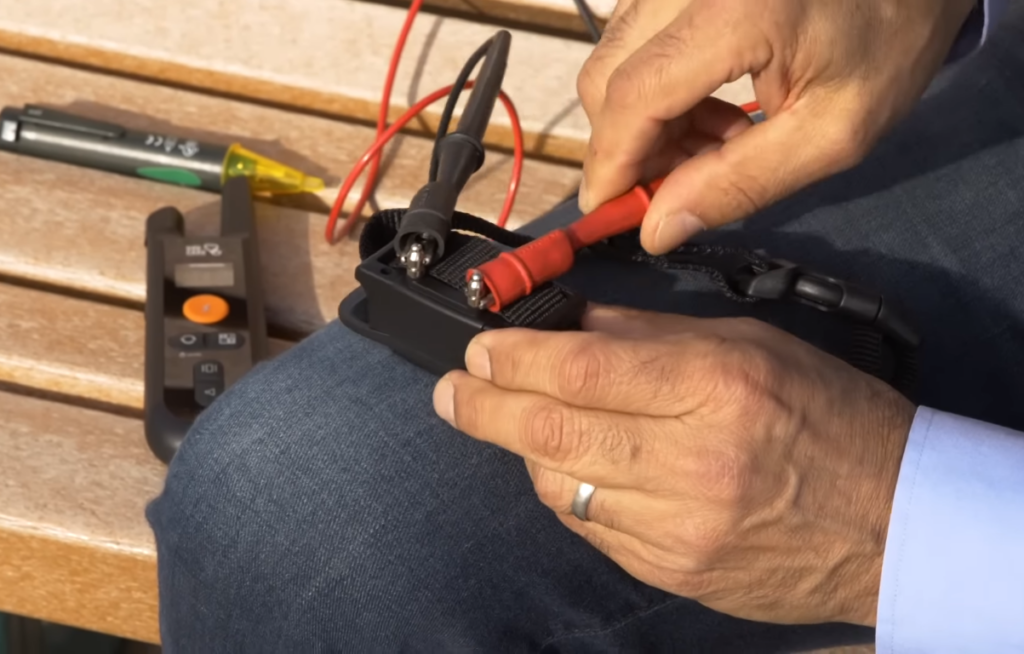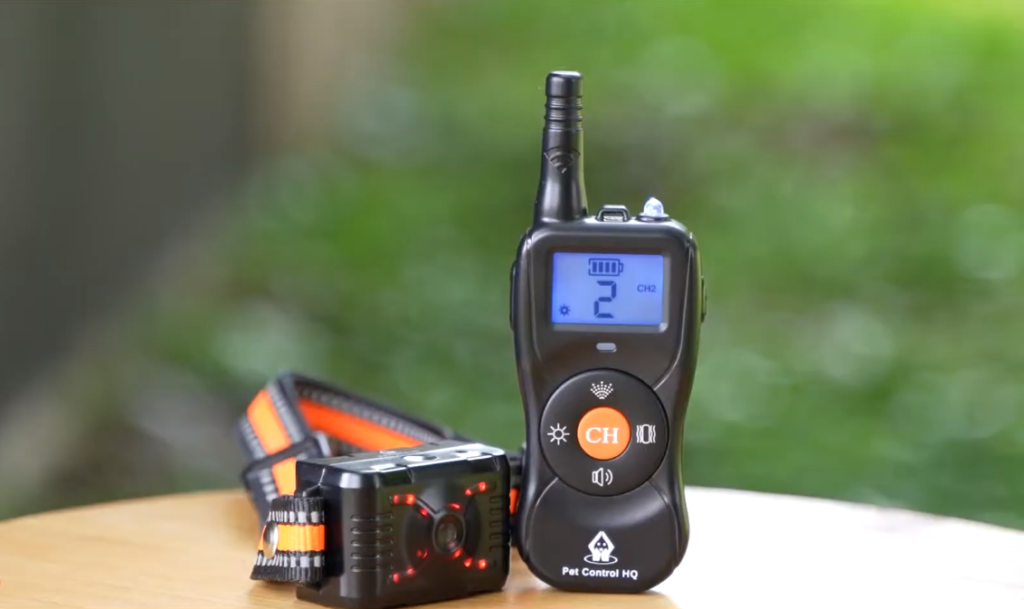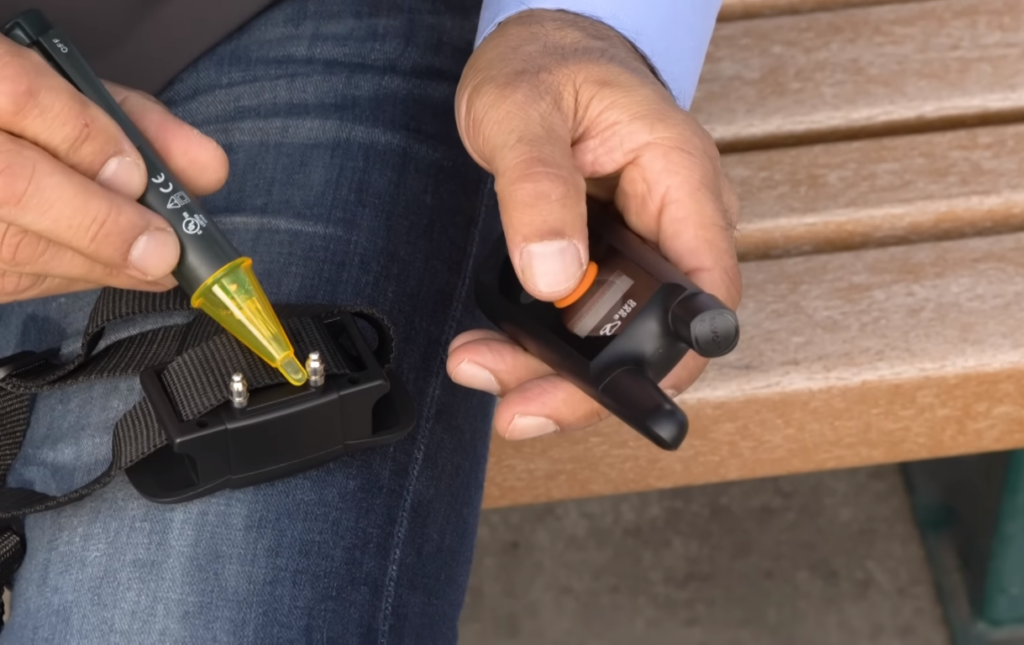Being a pet parent is no different than being a parent to a child. It’s a journey filled with enormous responsibilities. And training your pet dogs is one of the most difficult aspects of this journey, which demands a lot of patience and persistence.
One controversial technique dog owners/other professionals use during dog training is shock collars. Using shock collars for dogs raises the same questions as if the strict parenting style is an acceptable way to discipline.
Many find shock collars cruel, while others consider it okay to assert certain behavioral modifications, pet containment, and for obedience training.
In this article, we’re going to take an elaborate take on the scientific, emotional, and mental impact of using shock collars on your dogs; is it really okay to use shock collars? Read till the end.
What Are Dog Shock Collars?

Shock collars also referred to as electronic collars or remote training collar, are devices put around a dog’s neck that generate an electric shock/stimulus of varying intensity used by a dog trainer. They are meant to be tied around the dog’s neck.
Shock collars differ from conventional dog collars because two-pole electrodes penetrate the fur and are directly against the dog’s skin.
Once activated, an electric shock is generated, which at times is painful but doesn’t affect much otherwise. The discomfort/pain the shock brings depends on the induced voltage current.
The stimulation differs based on what type of shock collar you are using on what dog breed. There are three main types of shock collars for domestic dogs and others: Dog containment shock collars, Anti-bark collars, and Remote Training Collars. We will discuss each shock collar, aka e-collar, in detail later in this article.
How Many Volts is a Dog Shock Collar Generally?

A dog shock collar can be as light as 400 volts, which feels more like a good massager, and can go up to a range as hostile as 7000 volts; a truly painful experience. The tolerance level of every dog is different, so you need to evaluate your dog’s sensitivity, strength, etc., first and then proceed accordingly.
How Many Volts Are Generally Accepted As Safe in a Dog Electric Collar?
The voltage range generated by the electrode conductors between 1000 volts to 3500 volts is generally accepted and considered safe in dog electric collars. But as we already said, deeming a certain voltage range safe doesn’t work for every dog. And it’s usually about how a certain dog reacts to it.
More than the voltage, it’s the duration that matters. E collars should be for “structured training” only and not as full-time collars.
It is also important to note that modern shock collars do not cause pain but rather a sudden shock or surprise.
One of the benefits of using shock collars is that they can be operated remotely, allowing the owner to correct the dog’s behavior without their awareness. When the dog engages in undesirable behavior, the owner can press the button on the remote, causing the dog to be startled and associate the shock with their “wrong” actions.
This creates a natural association in the dog’s mind that links the undesired behavior with something unpleasant, making them less likely to repeat it.
The ultimate goal of dog training is to create a positive association where good behavior is rewarded with positive reinforcement, such as attention and treats, and undesirable behavior is associated with negative consequences, such as being startled or corrected.
Scientific Evidence Highlighting the Issues Associated With the Use of Electric Shock

There’s no denying the fact that shock collars are an effective technique to train hunting dogs as well as others. B.F Skinner, the father of Operant Training, spent a significant part of his life devoted to studying human/animal behavior and carrying out several experiments in this regard.
His negative reinforcement method, removing averse stimuli such as electric shocks, encourages the dogs to stop doing that certain thing to avoid discomfort. However, not without the possibility of impacting the subject’s (dog) health. Now, the tolerance capacity is not the same for every dog.
According to an experiment performed by Applied Animal Behavior Science, three groups of dogs were subjected to electrical shock whenever they disobeyed an order.
One of the groups didn’t show any drastic increase in the level of stress hormones. Alternatively, dogs in the other two groups showed a significant increase in the levels of a stress hormone called Cortisol in their saliva.
You can further look into the clinical signs caused by the use of electric training collars on dogs in everyday life situations.
The other complication comes with the possibility of your dog not being able to relate the negative stimulus to a particular situation. This is why trial and error makes electric shock unpredictable.
For instance, continuous exposure to the current volts via a dog shock collar without any noticeable/desired outcome leads to adverse effects and is straight-up cruel.
According to Applied Animal Welfare Science, prolonged debilitated high electric shock trials can lead to pathological anxiety in your dogs.
And for some dogs, especially with low tolerance, a painful electrical shock induces physical and mental trauma. This can instigate aggressive patterns, affecting the relationship between the owner and the dog.
Some vets and professional dog trainers deem it necessary to use electric shock collars, especially for stubborn and big-sized dog breeds. E collars, if used properly, can bring fruitful results, but even slight neglect can impact your dog’s mental and physical health, resulting in PTSD in rare cases.
So, before choosing a shock collar, ensure it’s safe, mild, and will bring minimal discomfort to your dog. Remember, your dog’s well-being matters the most!
Shock collars: Are They Cruel to Dogs?

If we subjectively try to answer this question, then yes. Using punishment to tackle unwanted behavior problems will always be of cruel essence, no matter what the voltage stimulation intensity is. Some vets and trainers might argue that modern-day shock collars aren’t as cruel as the high-voltage ones used previously.
However, the important angle we need to consider in answering this question is the likelihood of incorrect use of shock collars.
If not handled by professionals, it can take an abusive turn, unintendedly. Especially while dealing with higher voltages of about 4500, improper handling can make the shock collar hurt your dog, resulting in painful burns on its skin.
Besides, using electronic training collars for every small thing is harsh, even if the current is minor and ranges between 100-200 volts. E-collars should only be used in strictly specified situations by an expert with theoretical and practical qualifications in this subject matter.
We might sound biased here, but positive reinforcement training should always be your first choice, and shock collars the last.
In cases like having a super stubborn big-sized dog or when the positive reinforcement training is ineffective, you may turn to shock collars, but only if you’re an experienced dog owner or seeking professional trainers.
Shock Collars for Remote Training

Remote training shock collars allow you to summon and touch your dog without having to be physically/present. These devices have an electronic range from 0 percent to 100 percent stimulus intensity.
30-40 percent intensity is more than enough to get their attention. Make sure to properly time the behavioral cue, such as ‘come’ or ‘stop,’ with the electric stimulus.
Electronic pet containment systems, on the other hand, are utilized to keep your dog within the designated boundary so as to not leave the premises of the house. A wire buried underground makes up the invisible fences and sends signals to the collar if your dog tries to cross that, followed by a shock stimulus.
Shock Collars Used for Excessive Barking

Excessive barking is an unpleasant behavioral pattern in dogs that owners try to tackle differently. Dogs bark overly in excitement, boredom, annoyance, attention seeking, or due to any external disturbance.
Normal barking is obviously okay; that’s what dogs are supposed to do. However, overly barking is when it gets annoying, and there are shock collars to modify this bad behavior.
Shock collars used for excessive barking detect the vibrations in the dog’s vocal cords/throat and generate an electrical stimulus in the form of shock. Modern anti-bark shock collars work even when you’re away – perfect for dogs who bark all day once you leave the house.
You can control the stimulus intensity level with these collars, although always start low. Make sure to trim the dog’s fur from where the electrodes are placed.
The key to training dogs with an anti-dog shock collar is exposing them to factors that trigger barking, stopping them with commands, and then inducing the stimulus.
Can a Dog’s Throat Get Hurt by a Shock Collar?

Generally, any collar, if pulled by a strong force, can put a strain on your dog’s neck. In the case of shock collars, if your dog is exposed to a significantly high-volt current for more than 15 seconds, it can possibly cause pain or burn on your dog’s skin around the throat area.
The mistake most dog owners make is not taking the shock collar off once done. You shouldn’t keep an electric shock collar on for more than 12 hours. If your dog sleeps with an electronic collar on, it not only causes discomfort but can result in a mishap like strangulation or rashes on its skin.
Are Shock Collars Legal?
While the use of shock collars is widely looked down upon and considered cruel, some countries have gone a step ahead and have it banned.
The use of electronic shock collars is not legal in Germany, Norway, Austria, Sweden, Denmark, Slovenia, Portugal, Wales, Switzerland, Austria, some states in Australia, and the province of Quebec in Canada.
What is a Better Alternative to a Dog Shock Collar?
Can’t bring yourself to use electric training collars on the furry creature you love the most in the world? No problemo! There are better alternatives to shock collars that you may turn to and make your doggo showcase its best behavior.
Clickers
Clickers are a great tool to improvise behavioral cues. What you have to do is associate your verbal cues/instruction with a clicker. This way, your dog gets familiar with the sound.
To make them remember and implement it, reward them with a treat or good boy compliment right after they do something good/obey you.
Citronella Dog Collars

Citronella dog collars are one of the best alternatives to ani-bark shock collars. The spray is harmless, doesn’t cause any pain or discomfort, and just annoys your dog a little to get them to stop barking.
Citronella spray is an insect repellent, but it also works great as an animal repellent. Upon detecting the barking, this collar spurts citronella on your dog to distract them with its unpleasant smell.
According to a study, many dog owners found citronella dog collars to be helpful in reducing excessive barking and preferred them over electrical shock collars.
Drawbacks of Citronella Dog Collars
Using a citronella dog collar has its own shortcomings. For example, it is prone to causing skin problems like irritation and rashes.
Its small microphone in the circuit might punish your dog for detecting the barks from the dogs in the surrounding. Dogs with heavy coats might retain the smell of the spray, which can be irritating and unpleasant for your dog.
Pheromones
One of the reasons a dog barks excessively is rooted in stress and anxiety. Using pheromones and therapeutic scents in their collars can help them calm down and thus stop barking.
Using a Shock Collar Has its Advantages
Surely, there is a lot of criticism on the use of shock collars for being cruel, anti-animal, and their probability of negatively impacting your dog’s mental and physical health. These are all the drawbacks of using electronic shock collars.
But let’s see this controversial practice from a different angle for a minute and talk about the advantages using shock collars can have.

1- Quick Results
Training dogs, in general, is a strenuous journey, and it takes a long time to see any noticeable changes finally. However, using electronic collars correctly can aid in getting those results at a faster pace.
The fear element makes your dog obey the instruction to avoid the electronic stimulus, making shock collars an effective and swift measure to train a dog.
2- Good for Stubborn Dogs
Rewarding methods might not work effectively on dogs with stubborn or aggressive personalities. But the negative reinforcement techniques, like using a shock collar, work well with dogs having such a personality.
3- Give Owners the Control
Dogs with dominant personalities don’t allow their owners to have control over them and refuse to obey instructions.
By using dog shock collars, you can turn the tables. Not by being cruel per se, but by asserting your commands with the help of mild electric shock that the e-collars will generate. Which in turn helps you bond with them better.
4- Supervision of Dog’s Behavior Without You Having to be Present
One of the benefits of dog shock collar training is that you don’t need to be physically present to monitor their behavioral training.

The remote control allows you to supervise no matter where you are. Not to mention how the smart fence and bark collars automatically do the job for you with innovative signal/vibration detectors.
5- Adjustable Intensity
Using shock collars isn’t necessarily cruel if you keep the intensity to a minimum. For bigger dogs, which are typically harder to train, you can enhance the stimulation to some extent.
While for small and sensitive dogs, the vibration mode works quite well to get their attention and make them obey. Thus, giving you the flexibility to project your approach toward training.
6- An Affordable Way to Train Dogs
Shock collars are a cost-effective way to train your dog as compared to other training devices. You can get different types of shock colors with adjustable intensities based on the type of training you’re aiming at. All that in an affordable price range.
How Do You Get a Dog Used to a Shock Collar?

First, remember you don’t use shock collars on your dogs to punish them if they disobey you. They are rather the tools to communicate more effectively. Ensure you buy the best dog training collar, used and recommended by other dog owners.
Now, there’s no exact age to start using the e-collar on your dog. However, six months old is widely considered old enough to get your dog started.
It’s true that bigger dogs need the electric shock stimulus a little stronger; still, you need to start low. Your dog’s sensitivity must also be considered, so proceed accordingly.
Start with the vibration mode; it is enough to get your dog’s attention. It is possible that you wouldn’t need to go beyond this initial mode.
If your dog isn’t reacting to the electric shock, you may increase the stimulation a little. And before doing that, ensure the collar’s contact points are properly snuggled against your dog’s skin. You might need to trim the fur a bit from that area to make it function properly.
Associate the shock collar with something rewarding to get your dog used to it better. For instance, after feeling the electrical stimulation, they will know obeying the instruction will get them a treat/any positive reinforcement.
One thing you need to remember is that you can’t afford to be too individualistic when it comes to training your dog with shock collars. Especially if you don’t have any prior experience. Consulting professional dog trainers to help you is a much more viable option than putting your dog’s welfare at risk.
Keeping the shock collars on your dog’s neck all the time or for long hours is super uncomfortable. It is also one of the reasons dogs don’t get used to it. That’s why always take the electronic shock collar off once you’re done training your dog for the day.
One more thing, the nature of every dog is different. If you have a sensitive dog, it might not be worth forcing them harshly to get used to the collar. It will take a toll on their mental and physical health. So, you should know when to quit.
Do Vets Recommend Shock Collars?

Most vets and experts don’t recommend the use of shock collars. Many Animal Welfare organizations also strongly oppose it. The assertion on stopping the use of electronic collars is due to the high probability of misuse, abuse, deteriorating impact on your dog’s health, and incompetency of the owners to handle it properly.
Besides, negative reinforcement tends to be less effective than positive reinforcement generally. Sometimes, the dog trainer and vet clash over the use of electronic shock collars.
FAQs
Do Humans feel the impact of Ground Dog Shock Collars?
Unless you’re holding the receiver or collars, ground shock collars won’t cause any harm. But to ensure it’s working, you might need to test it out by experiencing the volt current. Which can be a little unpleasant, so make sure to set the intensity of the current from low to medium.
How many Volts Would Kill a Dog?
It isn’t necessarily the number of volts that could kill your dog; it’s the time your dog was exposed to the stimulus. For instance, it can be lethal if your dog touches the metal surface of tray voltage electrodes directly with their paws.
Conclusion
No matter how many opinions and debates you read/listen to in favor/against the use of electronic shock collars, in the end, it’s for you to decide. There’s no doubt e-collars make training easier and swifter, but the probability of damaging consequences cannot be ignored as well.
No matter what method you choose to train your dog, just be kind and gentle to these innocent souls.


